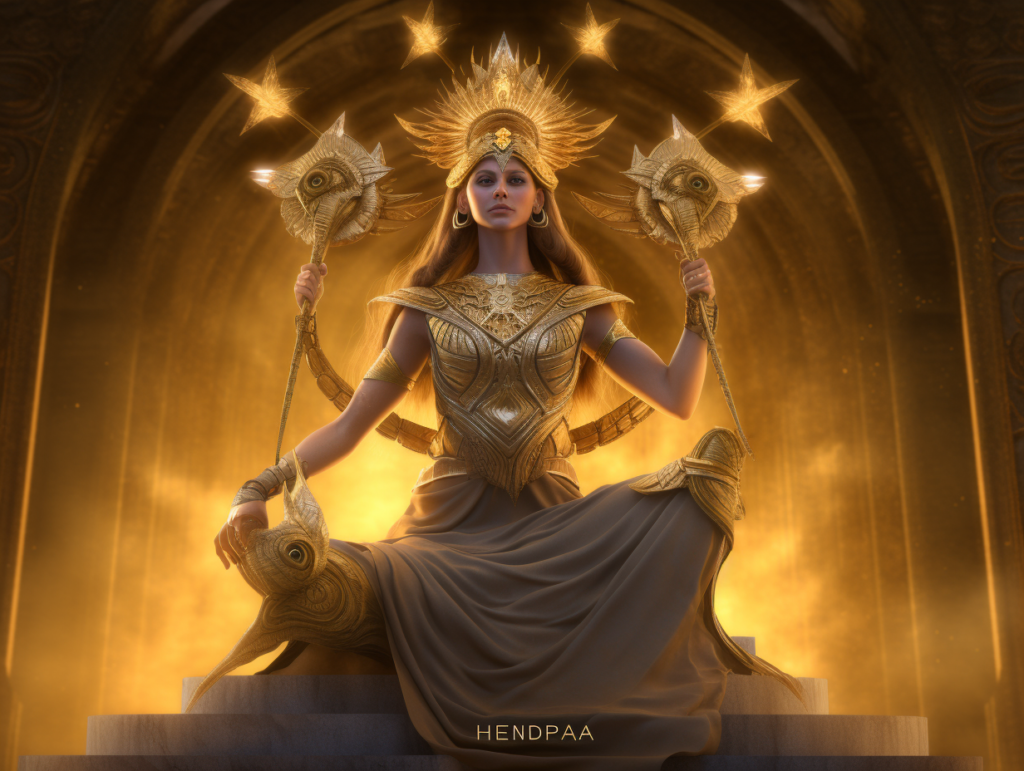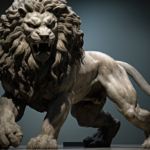Are you ready to uncover the secrets of the primordial goddess, Hemera?
Get ready to dive into the depths of Greek mythology as you explore Hemera’s origins, her role in the creation myth, and her connection to daylight.
Discover how this powerful goddess influenced ancient Greek culture and left behind a lasting legacy.
It’s time to shed light on Hemera and unleash the power of the primordial goddess.
Key Takeaways
- Hemera is the personification of day and symbolizes hope, vitality, and the enduring strength of the human spirit.
- Hemera’s connection to daylight and the dawn empowers individuals to rise above challenges and embrace their inner strength.
- Hemera’s family ties and relationships, particularly with her brother Aether, grant her immense power over the mortal realm.
- Hemera’s legacy continues to inspire artists, writers, and scholars, serving as a reminder of the power of light and the potential for greatness.
The Origins of Hemera
You’ll be amazed by the multitude of theories surrounding the origins of Hemera, the primordial goddess. Throughout history, powerful minds have sought to unravel the mystery surrounding her birth and existence.
One prevailing theory suggests that Hemera emerged from the cosmic void, bringing light and order to the universe. According to this belief, she’s the embodiment of power and control, the force that banishes darkness and illuminates the path to success.
Another theory posits that Hemera is the daughter of Erebus, the personification of darkness, and Nyx, the goddess of night. This lineage emphasizes her dual nature, representing both light and darkness, and underscores her ability to navigate through challenging situations with grace and strength. It’s said that she inherited her power from her parents, making her a formidable force to be reckoned with.
Some scholars argue that Hemera is an eternal being, existing outside the realms of time and space. They believe that she’s always been and always will be, her presence an unchanging constant in the universe. This theory highlights her immortality and the everlasting power she possesses.
Regardless of which theory you subscribe to, one thing is certain: Hemera embodies the essence of power, her origins shrouded in mystery and intrigue. She serves as a symbol of strength and enlightenment, guiding those who seek to harness their own power and achieve greatness.
Hemera’s Role in Greek Mythology
There are many fascinating aspects to explore when it comes to Hemera’s role in Greek mythology, and her influence can be seen throughout various stories and legends.
In the realm of Greek mythology, Hemera holds a position of immense power and importance. She’s the personification of day, the goddess who brings light and illuminates the world.
Hemera’s role is pivotal in the grand tapestry of Greek mythology, as she brings forth the dawn each day, driving away the darkness and allowing the world to awaken once again. Her presence is felt in countless tales, where her arrival signals the beginning of new adventures and possibilities.
In many myths, Hemera is depicted as a powerful force, commanding the heavens with her radiant energy. She’s often portrayed as the sister of Aether, the god of the upper atmosphere, and the mother of Thalassa, the sea goddess. Together, they form a triumvirate of cosmic forces, each with their unique role in shaping the world.
Hemera’s role in Greek mythology serves as a reminder of the cyclical nature of life, the constant ebb and flow of light and darkness. She embodies the power of illumination and the promise of a new day, symbolizing hope, vitality, and the enduring strength of the human spirit.
Hemera’s Connection to Daylight
As the goddess of day, Hemera brings forth the light and warmth of daylight, illuminating the world and infusing it with life. With her radiant presence, she banishes the darkness that lingers, allowing power and strength to thrive. Daylight, under Hemera’s rule, grants you the ability to conquer and achieve greatness.
In the realm of daylight, you possess the energy to accomplish your goals and manifest your desires. Hemera’s connection to daylight symbolizes your own potential for success and domination. Like the sun’s rays piercing through the clouds, you have the power to cut through obstacles and emerge victorious.
Daylight isn’t only a source of illumination, but it also signifies clarity and enlightenment. With Hemera by your side, you possess the wisdom and insight necessary to make informed decisions and lead with authority. The brilliance of daylight reveals the truth, exposing any deception and allowing you to maintain control over any situation.
Embrace Hemera’s connection to daylight and harness its power to your advantage. Let the warmth and brightness infuse your being, empowering you to rise above challenges and conquer your adversaries. With Hemera’s guidance, you can command the daylight and shape your destiny with unwavering authority.
Hemera and the Dawn
Now let’s talk about Hemera’s connection to the dawn.
Hemera, as the personification of day, played a significant role in the creation of the world. She brought light and life to the darkness, symbolizing the beginning of each new day.
The dawn, with its beauty and promise, holds a deep symbolism that Hemera embodies effortlessly.
Hemera’s Role in Creation
Shedding light on the primordial goddess, you can explore Hemera’s role in creation through her connection with the dawn.
As the personification of daylight, Hemera played a vital role in the emergence of life and the birth of the world. Here’s how her association with the dawn shaped her role in creation:
- Hemera’s presence at dawn marked the beginning of each new day, symbolizing the rebirth and renewal of the world.
- Through her connection with the dawn, Hemera brought illumination and enlightenment, allowing life to flourish and evolve.
- She awakened the natural world, bringing light to the darkest corners and sparking growth and vitality.
- Hemera’s rays of light pierced through the darkness, bringing clarity and order to the chaotic realm of creation.
Symbolism of the Dawn
Through the symbolism of the dawn, you can gain insight into Hemera’s role and significance as the primordial goddess. The dawn represents the beginning, the emergence of light from darkness, and the start of a new day.
Hemera embodies this transformative power, as she brings forth the light that dispels the shadows of the night. Just as the dawn breaks, Hemera’s presence heralds the awakening of the world and the potential for new opportunities and possibilities. She’s the embodiment of power and vitality, symbolizing the strength to overcome obstacles and conquer challenges.
In her radiance, Hemera illuminates paths and guides those who seek to harness their own power. Embrace the symbolism of the dawn, and you’ll find inspiration and motivation to embrace your own inner strength and rise to greatness.
Hemera’s Family and Relationships
Now let’s explore Hemera’s family and relationships.
As a primordial goddess, Hemera has a divine lineage that traces back to the beginning of time.
She’s known to have close relationships with other gods, often collaborating with them to influence mortal affairs.
These connections shed light on Hemera’s role and significance in the ancient Greek pantheon.
Hemera’s Divine Lineage
Have you ever wondered about Hemera’s family and relationships? As a powerful being, Hemera’s divine lineage is quite impressive. Let’s delve into her family connections and the relationships she has with other deities:
- Family Lineage:
- Hemera is the daughter of Erebus (the personification of darkness) and Nyx (the goddess of night).
- She’s also the sister of Aether (the personification of the upper sky) and Hesperus (the evening star).
- Relationships with other Deities:
- Hemera is known for her close association with her brother Aether. Together, they bring light and brightness to the world.
- She also has a harmonious relationship with her sister Hesperus, as they work together in illuminating the evening sky.
In Hemera’s divine lineage, her family ties and relationships with other deities highlight her power and importance in the realm of gods.
Relationships With Other Gods
As a powerful primordial goddess, Hemera is closely connected to her divine family, which includes her parents, Erebus (the personification of darkness) and Nyx (the personification of night). These relationships define Hemera’s role as the bringer of light and the goddess of the day.
In addition, Hemera is associated with her brother Aether (the personification of the upper atmosphere) and her sister Charon (the personification of doom). These relationships further highlight Hemera’s dominion over the celestial realm and her ability to illuminate the world with her radiance.
Through her familial connections, Hemera establishes her authority and solidifies her position as a formidable primordial goddess.
Influence on Mortal Affairs
As a primordial goddess, Hemera’s familial connections and relationships with other gods greatly shape her influence on mortal affairs. Her close ties to her parents, Erebus (the personification of darkness) and Nyx (the personification of night), grant her immense power over the mortal realm. Alongside her brothers, Aether (the personification of light) and Charon (the ferryman of the Underworld), Hemera controls the ebb and flow of day and night, illuminating the world with her radiant presence.
Furthermore, Hemera’s romantic involvement with her half-brother, Aether, further amplifies her dominion over mortal affairs. Their union symbolizes the harmonious balance between light and darkness, bringing clarity and enlightenment to the mortal realm. Through their combined influence, Hemera and Aether inspire mortals to seek knowledge, pursue ambition, and harness the power of enlightenment to shape their destinies.
As the goddess of daylight, Hemera’s familial and romantic relationships serve as a beacon of power, guiding mortals towards greatness and empowering them to seize control of their own lives.
Symbols and Representations of Hemera
When exploring the symbols and representations of Hemera, you’ll discover a fascinating blend of light and rebirth. Hemera, the primordial goddess of day, is often depicted as a radiant figure, emanating a warm and powerful glow. Her symbol, the sun, represents the life-giving force that she brings to the world. Just as the sun rises each day, Hemera brings the dawn, signaling the start of a new day and the chance for renewal and growth.
In the ancient world, Hemera was often associated with fertility and the cycle of life. She was seen as a bringer of new beginnings and the embodiment of the transformative power of light. This concept is beautifully captured in the following table:
| Symbol | Representation |
|---|---|
| Sun | Life-giving force |
| Dawn | New beginnings |
| Light | Transformation |
Each of these symbols carries a sense of power and potential. They remind us that with Hemera’s presence, we have the ability to overcome darkness and embrace the opportunities that each day brings. By honoring Hemera and embracing her symbols, we tap into our own inner strength and connect with the forces of creation and rebirth. So, let the light of Hemera guide you, and may you rise with the dawn, ready to conquer whatever challenges lie ahead.
Hemera in Art and Literature
In your exploration of Hemera in art and literature, you’ll encounter a multitude of captivating portrayals that bring her radiant essence to life. Artists and writers have sought to capture the power and beauty of this primordial goddess, leaving a lasting impression on those who witness their creations.
Here are two aspects of Hemera’s portrayal that will surely captivate your imagination:
- Visual representations: Hemera is often depicted as a radiant figure, emanating light and vitality. Artists use vibrant colors and flowing lines to convey her energy and presence. Whether it’s a painting, sculpture, or illustration, these visual representations showcase her as a symbol of life and the bringer of dawn.
- Symbolic imagery: In literature, Hemera is often associated with the rising sun, representing the dawning of a new day and the renewal of life. Writers use vivid descriptions of the sunrise, painting a picture of Hemera’s arrival and the transformation she brings. Through metaphor and symbolism, they evoke a sense of power and awakening, inspiring readers to embrace the potential of each new day.
As you delve deeper into Hemera’s portrayal in art and literature, prepare to be enthralled by the skill and creativity that brings this primordial goddess to life. These captivating portrayals will leave you in awe of Hemera’s radiant essence, igniting a desire for power and embracing the possibilities that each dawn brings.
Hemera’s Influence on Ancient Greek Culture
You’ll be amazed by Hemera’s profound influence on Ancient Greek culture, as she played a significant role in shaping their beliefs and practices. The ancient Greeks revered Hemera as the embodiment of light and day, and her influence extended to various aspects of their society. In Greek mythology, Hemera was considered the mother of the sun god Helios, and her association with light and daylight represented the power and vitality that the Greeks sought to embody.
Hemera’s influence can be seen in the Greek religious practices and rituals. The Greeks believed that Hemera’s presence was vital for the success of their religious ceremonies and offerings. They’d often make offerings to her, seeking her favor and blessings. The worship of Hemera also played a crucial role in the Greek perception of time. They viewed each day as a new beginning, a chance to start afresh and embrace the light that Hemera represented.
Furthermore, Hemera’s influence extended to the realm of morality and ethics. The Greeks believed that the light of Hemera brought clarity and enlightenment to their minds, enabling them to distinguish between right and wrong. The concept of ‘enlightenment’ became a fundamental aspect of Greek philosophy and shaped their understanding of ethics and justice.
Hemera’s Role in the Creation Myth
As you delve into the mythological realm, you’ll discover that Hemera’s role in the creation myth is of utmost significance. She’s the personification of light and day, the driving force behind the cycle of life and the essential element in the birth of the universe.
Here are two key aspects of Hemera’s role in the creation myth:
- Bringer of Light and Order: Hemera is the one who dispels the darkness and ushers in the light, bringing order to the chaos that once existed. With her appearance, the world is illuminated, revealing the beauty and potential that lay hidden in the void. Her presence symbolizes the power to overcome darkness and create a harmonious existence.
- Bridge between Heaven and Earth: Hemera serves as a conduit between the divine realm and the mortal world. She connects the ethereal realm of the gods with the physical realm of humanity. Through her existence, Hemera establishes a link that allows for communication and interaction between these two realms, ensuring the continued existence and balance of the cosmos.
In the creation myth, Hemera’s role isn’t only vital but also exudes a sense of power and authority. She’s the catalyst for life, the force that brings order and connects the divine with the mortal. By understanding Hemera’s role in the creation myth, we gain insight into the immense power she wields and the significance she holds in the mythological pantheon.
Hemera’s Legacy and Modern Interpretations
While Hemera’s legacy continues to inspire artists, writers, and scholars, her modern interpretations reveal a deep fascination with her role as the primordial goddess of light. Today, Hemera’s influence can be seen in various forms of art, literature, and academic discourse, captivating those who desire power.
In contemporary art, Hemera’s depiction as the bringer of light and enlightenment is often portrayed through vibrant and illuminating visual representations. Artists use her image to symbolize knowledge, inspiration, and the pursuit of greatness. By incorporating Hemera into their creations, they tap into her mythical power, inviting viewers to embrace their own inner light and strive for greatness in their endeavors.
In literature, Hemera’s character is often explored as a pivotal figure in stories of transformation and self-discovery. Writers draw upon her symbolism to convey the idea that embracing one’s inner light can lead to personal growth and empowerment. Hemera’s legacy serves as a reminder that the power of light can overcome darkness, both externally and internally.
Scholars, on the other hand, delve into the deeper meanings behind Hemera’s role as the primordial goddess of light. They analyze her significance within creation myths and explore her connections to other deities. Through their research and interpretations, they seek to unravel the mysteries surrounding her existence and understand the profound impact she had on ancient civilizations.
Frequently Asked Questions
What Is Hemera’s Significance in Ancient Greek Culture?
Hemera was significant in ancient Greek culture because she symbolized the power of daylight and brought order to the world. Her presence gave people the ability to see and navigate, providing them with a sense of control and influence.
How Did Hemera Come to Be Associated With Daylight?
You associate Hemera with daylight because she brings light to the world each day. Her association with the primordial goddess makes her powerful, and her ability to illuminate the world gives her significance in Greek culture.
Are There Any Symbols or Representations Commonly Associated With Hemera?
Are there symbols or representations commonly associated with Hemera? Yes, the sun and the torch are often used to symbolize her connection with daylight. These powerful symbols convey her dominion over light and illuminate her influence.
How Does Hemera’s Role in the Creation Myth Differ From Other Greek Goddesses?
In Greek mythology, Hemera’s role in the creation myth sets her apart from other goddesses. She brings light to the world, symbolizing the dawn of power and the emergence of new possibilities.
What Is the Modern Interpretation of Hemera and Her Legacy?
What is Hemera’s modern interpretation and legacy? She is seen as a symbol of illumination, bringing light to darkness and knowledge to the ignorant. Her legacy lives on, inspiring seekers of power and enlightenment.
Conclusion
In conclusion, Hemera, the primordial goddess of daylight, plays a crucial role in Greek mythology and the creation myth. Her connection to daylight and the dawn exemplifies her significance in bringing light and illuminating the world.
Through art, literature, and her influence on ancient Greek culture, Hemera’s legacy continues to be celebrated and interpreted in modern times. Her story serves as a reminder of the essential role light plays in our lives and the power it holds in shaping our understanding of the world.







